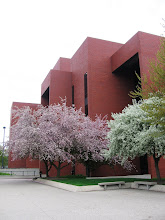4th Annual Faculty Technology Showcase Highlights Use of Technology for Classroom Instruction at Ball State University
At the Fourth Annual Faculty Technology Showcase, held Wednesday afternoon, March 7, 2007 at Ball State University’s Bracken Library, several classroom faculty shared their use of technology in teaching and learning with the campus community through their interactive exhibits.
Dr. Arthur W. Hafner, Dean of University Libraries, said that the annual Faculty Technology Showcases are very popular and are well attended by other faculty. “Using this forum is an excellent way for faculty to share their experiences with others and to promote technology.”
Attendees were offered a unique opportunity to discuss the projects one-on-one with presenters and to see demonstrations of how specific technology is used in the classroom and on campus.
“Faculty teaching faculty has always been a successful approach to creating an enriched classroom,” said Dr. David R. Pearson, Associate Professor of Physical Education and chairperson for the Information Technology Advisory Group (ITAG).
“It was a great showcase,” said Ball State University President Jo Ann Gora, who spent time talking with several faculty and studying their exhibits. “I learned a lot.”
Dr. Donald E. Van Meter, Associate Dean of the College of Sciences and Humanities, said, “The Showcase was an excellent chance for me to see how faculty are using technology in teaching. I was especially interested in the ways Dr. Guohe Zheng uses a Tablet PC to teach his Japanese language classes. I was also quite interested in learning how GIS is being used in journalism classes.”
Yasemin Tunç, Director, University Libraries’ Technology Training Support Services, coordinated the popular fourth annual event with assistance from Technology Training Specialists Linda M. Putman and Barbara R. Wills. The unit’s personnel continually offer sessions to assist faculty and staff in learning about a variety of software and hardware for classroom instruction and office productivity.
A new concept called Distributed Podcasting was presented by Dr. Matthew J. Stuve, Department of Educational Studies and demonstrated by Van Hnem Bualteng, a graduate student enrolled in Dr. Stuve’s EdTec 485 class, Distance Learning and School Infrastructures. Attendees learned how anyone with a BookPod account can publish content to a common podcast.
Using Wikis for Collaboration was the focus of the exhibit by Dr. John B. Horowitz, Department of Economics. In his classes, he uses wikis to post topics and discussions in the classroom. He reports that students find the wikis a convenient “go to” site to review terms and concepts.
Dr. Lisa F. Huffman, Department of Educational Psychology, and Mark J. Lora, Assessment System Programmer, Teachers College, demonstrated Rubric-Based Assessment with rGrade. The rGrade software has all of the features of a grade book with the added power to include performance-based rubrics linked to course standards and objectives. Students can use this information to follow their own progress as they move through the course. “This means increased accountability for both instructors and students,” said Dr. Huffman.
Sheryl A. Swingley, Instructor, Department of Journalism, and Angela S. Gibson, University Libraries’ Geographic Information Systems (GIS) Specialist, demonstrated the Use of Geographic Information Systems in Journalism. The exhibit featured their collaboration in the classroom to show students how GIS software can be used in researching and reporting news to illustrate data or to show trends by creating data-driven maps.
Dr. Guohe Zheng, Modern Languages and Classics, featured Using a Tablet PC in the Classroom. “Thanks to a powerful PC featured called Phoentic Guide of Asian Language, students can visit various Japanese newspaper Web sites, copy any article they wish to read, then a Word file provides the pronunciation of all of the kanji or characters by using only a few clicks of the mouse,” he said. Dr. Zheng also uses the Tablet PC to input Japanese characters, teach note-taking by handwriting, mark lecture notes, convert handwritten texts into printed ones, and add pronunciation notes to kanji.
For more information, or to arrange for a technology consultation, contact Yasemin Tunç, Ball State University Libraries’ Director for Technology Training Support Services, YTunc@bsu.edu, (765) 285-5902.
This article first appeared in The Library Insider 5(3): 3; March 2007.
Labels: academic libraries, Ball State University, classroom, Libraries, technology


0 Comments:
Post a Comment
<< Home